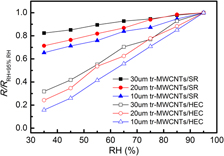Crossref Citations
This article has been cited by the following publications. This list is generated based on data provided by
Crossref.
Liu, Ping
Huang, Ying
Liu, Caixia
Wang, Yue
Guo, Xiaohui
Zhang, Yugang
and
Ge, Yunjian
2015.
Enhanced electrical conductivity and mechanical stability of flexible pressure-sensitive GNPs/CB/SR composites: Synergistic effects of GNPs and CB.
Journal of Materials Research,
Vol. 30,
Issue. 22,
p.
3394.
Huang, Ying
Wang, Weihua
Sun, Zhiguang
Wang, Yue
Liu, Ping
and
Liu, Caixia
2015.
A multilayered flexible piezoresistive sensor for wide-ranged pressure measurement based on CNTs/CB/SR composite.
Journal of Materials Research,
Vol. 30,
Issue. 12,
p.
1869.
Huang, Ying
Wang, Yue
Gao, Le
He, Xiaoyue
Liu, Ping
and
Liu, Caixia
2017.
Characterization of stretchable SWCNTs/Lycra fabric electrode with dyeing process.
Journal of Materials Science: Materials in Electronics,
Vol. 28,
Issue. 5,
p.
4279.
Turkani, Vikram S.
Maddipatla, Dinesh
Narakathu, Binu B.
Saeed, Tahseen S.
Obare, Sherine O.
Bazuin, Bradley J.
and
Atashbar, Massood Z.
2019.
A highly sensitive printed humidity sensor based on a functionalized MWCNT/HEC composite for flexible electronics application.
Nanoscale Advances,
Vol. 1,
Issue. 6,
p.
2311.
Zou, Xiao-Hang
Zhao, Si-Wei
Zhang, Ji-Guo
Sun, Hui-Liang
Pan, Qing-Jiang
and
Guo, Yuan-Ru
2019.
Preparation of ternary ZnO/Ag/cellulose and its enhanced photocatalytic degradation property on phenol and benzene in VOCs.
Open Chemistry,
Vol. 17,
Issue. 1,
p.
779.
Zhu, Penghui
Liu, Yu
Fang, Zhiqiang
Kuang, Yudi
Zhang, Yazeng
Peng, Congxing
and
Chen, Gang
2019.
Flexible and Highly Sensitive Humidity Sensor Based on Cellulose Nanofibers and Carbon Nanotube Composite Film.
Langmuir,
Vol. 35,
Issue. 14,
p.
4834.
Bouhamed, A
Rajendran, D
Frenzel, P
Zubkova, T
Al-Hamry, A
Miesel, D
Kamatchi, V
Ramalingame, R
Bautista-Quijano, J R
Lang, H
Baumann, R R
and
Kanoun, O
2021.
Customizing hydrothermal properties of inkjet printed sensitive films by functionalization of carbon nanotubes.
Nanotechnology,
Vol. 32,
Issue. 10,
p.
105708.
Chen, Jianwen
Zhu, Yutian
Chang, Xiaohua
Pan, Duo
Song, Gang
Guo, Zhanhu
and
Naik, Nithesh
2021.
Recent Progress in Essential Functions of Soft Electronic Skin.
Advanced Functional Materials,
Vol. 31,
Issue. 42,
Huang, Liang
Hu, Qichang
Gao, Sheng
Liu, Wei
and
Wei, Xuan
2023.
Recent progress and applications of cellulose and its derivatives-based humidity sensors: A review.
Carbohydrate Polymers,
Vol. 318,
Issue. ,
p.
121139.
Bistriceanu, Madalina Elena
Chibac-Scutaru, Andreea Laura
Tudorache, Florin
Zhang, Sufeng
and
Coseri, Sergiu
2025.
Interchangeable films made from cellulose acetate and different types of carbon nanotubes with humidity sensing capabilities.
Sustainable Materials and Technologies,
Vol. 43,
Issue. ,
p.
e01237.



